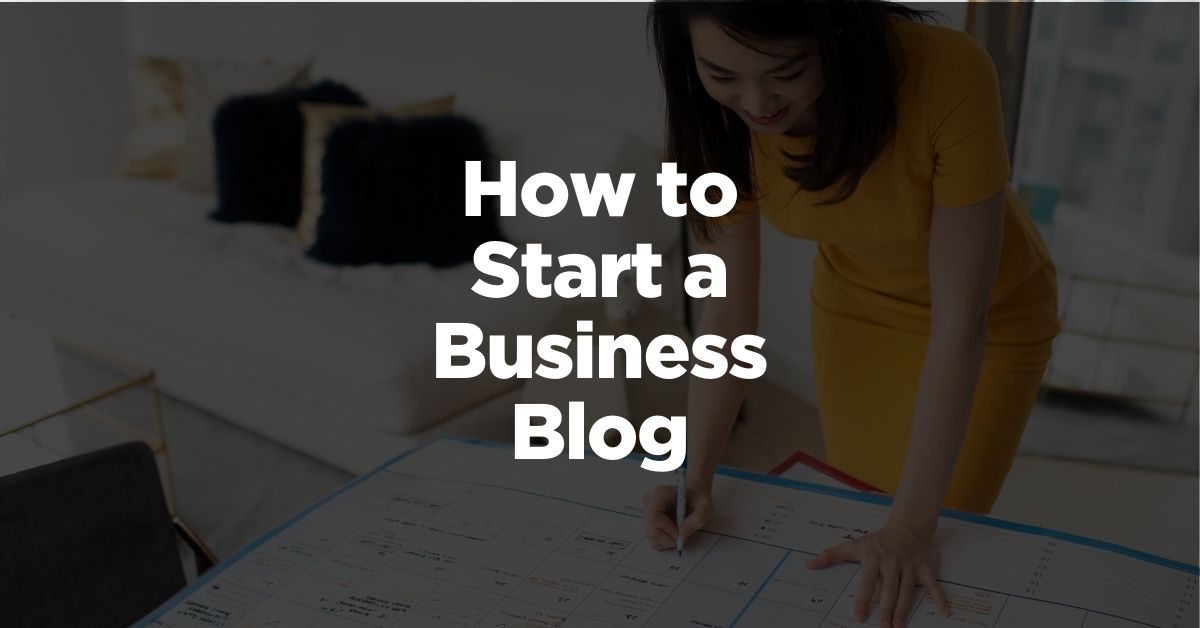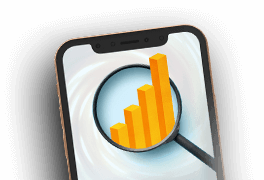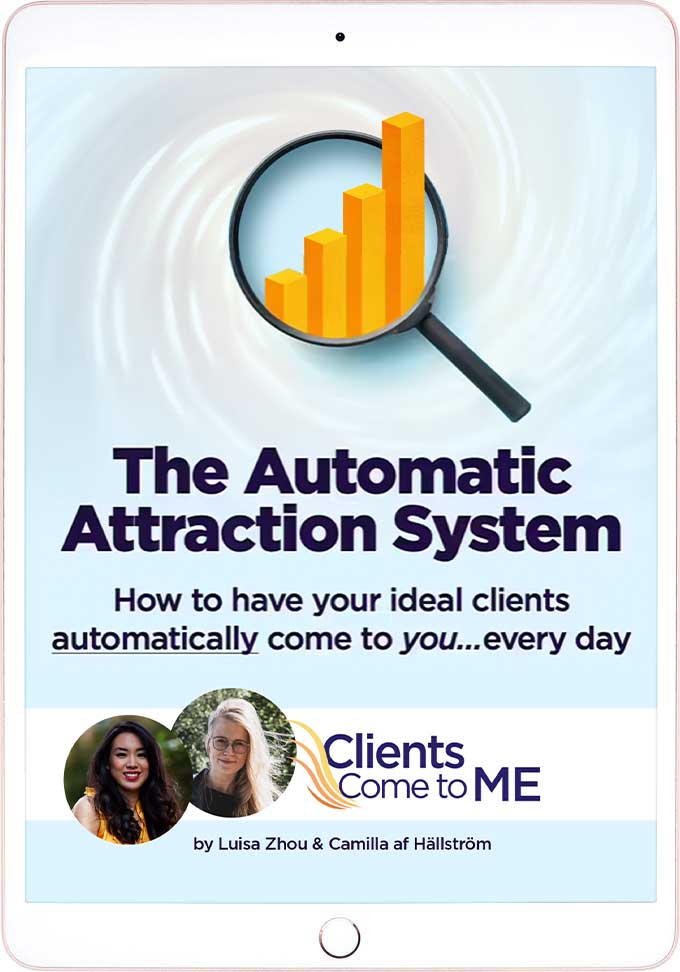This is the ultimate guide on how to start a business blog.
Whether you want to drive traffic to your business website with a blog or turn a blog into a business, you’re in the right place.
Ready to increase your income with a thriving blog? Read on.
How to start a business blog in 2024
- Find a niche
- Choose a blog name and hosting platform
- Understand your audience
- Make money blogging
- Write blog posts
- Grow your blog
What is a blog?
A blog is a website that contains content on a specific topic.
Blogs can be about anything, such as…
- Business and entrepreneurship
- Beauty
- Career
- Health
…And so on.
Blogs tend to be more conversational and less objective than news articles.
Businesses typically start blogs to increase leads and sales, improve brand awareness, and position themselves as “go-to” businesses in their industry.
Ultimately, blogging is a long-term marketing strategy. It takes time to build a blog – often several months.
That said, blogging has plenty of benefits. For example, if you optimize your blog to rank in search engines, you get “free” organic traffic to your website. That’s why blogging is so profitable and scalable.
But how do you start a blog? Let’s take a look.
The 4-Step Automatic Attraction System
for attracting more clients daily... without paid ads, social media, or "hustle"!
How to start a blog
What’s the best strategy for building a blog?
In terms of blogging and SEO, the path to growth is straightforward. You need to create blogs and you need to promote them.
Let’s start from the very beginning…If you don’t have a niche yet, here’s how to find yours:
1. Find your niche
To find your blog (and business) niche, you can look at a few places for clues:
- What skills have you learned?
- What questions do people frequently ask you?
Make a list of all the skills you’ve ever learned.
For example, when I started my first online business, I looked at skills like career coaching, Excel consulting, and, finally, digital advertising as potential business niches.
All of these were skills I had learned in my day jobs.
But your skills could also be things you’ve learned outside of your job.
Once you have a list of skills, narrow it down to the topics that people ask you about.
Now, you don’t have to find a skill you’re extremely “passionate” about. Passion doesn’t help you build a successful business or blog.
But you should pick one that you think is somewhat interesting.
For example, when I was finding my niche, I first tested Excel consulting. However, I quickly realized I wasn’t motivated enough to work on it every day.
So go for a topic you think is interesting enough – you can work on it long-term even if it’s not your biggest passion. That’s what I did with digital advertising when I started helping small businesses advertise online.
Now, think about the audience that might want blog content about this topic.
AKA your target audience.
Figuring out who you want to serve will help you write better blogs for that audience.
Put all of these elements together and you’ll get a simple tagline:
- “Executive coaching for new managers”
- “Health advice for new moms”
- “Digital marketing tips for small business owners”
That’s how you find your niche.
Want an even simpler approach?
Here’s a video to help you figure out your niche in one sentence:
However, if you already have a business, then use your business niche for your blog.
Your blog should sell your products and services so the topics you write about should be closely related to those.
Once you’ve defined your niche, you can set up your blog.
We’ll talk about how in the next step.
2. Buy a domain name and choose a blogging platform
To build a blog, you need both a domain name and a blogging platform.
We’ll look at both below.
Blog name
To start, let’s talk about naming your blog.
If you’re adding a blog to your existing business then you can skip this part.
But if this is a new blog or business website, you need a blog name.
I don’t recommend you worry about this too much.
If you’re in doubt, use your own name and build it as a personal brand. Just like I use “LuisaZhou.com” as my business name.
However, if you don’t want to use your own name or you want a more creative name, check out Spotify’s business name generator.
Then, the name you choose needs to be available on a domain service.
You need a domain name (www.domain.com) to build your blog. If your name is taken, you can add a word to it. For example: www.yournameconsulting.com.
To find and buy domain names, I recommend Hover. You typically find .com domains for $14.99/year.
Blog platform
The next step is to choose the right blogging platform.
There are self-hosted and hosted platforms.
Self-hosted means you need a hosting provider to support your blog. You build it on a content management system and then connect a hosting provider to it.
Hosted blogs are drag-and-drop platforms where you get access to a full blogging platform and don’t have to build your own blog.
While hosted platforms might be easier for someone who hasn’t built a blog before, there’s a huge drawback.
These platforms aren’t as flexible as self-hosted platforms. They can hurt things like your website performance, which, in turn, can affect how well your website ranks in search engines.
That’s why I recommend building your blog on a self-hosted platform.
The best self-hosted platform is WordPress.org, which is used by 40% of the websites on the internet. WordPress isn’t a perfect platform, but it gets the job done.
In terms of hosting platform, go for WPEngine.
You also need a theme to design your blog. There are plenty of pre-built themes (that are pretty much drag-and-drop options). Elementor is a great option.
I share the steps of building a WordPress website here.
A few drag-and-drop content management systems are:
- Squarespace: This website builder is, in most cases, the best option if you’re looking to build a blog with a drag-and-drop tool. Squarespace focuses quite a bit on improving their users’ searchability in search engines.
- Medium: You build your blog on a separate platform. You can’t really design your own blog but need to use Medium’s format. Typically, Medium isn’t the best option for a business blog.
- Substack: Substack is a newsletter service, so it’s technically not a blog platform. I don’t really recommend that you build your blog on Substack; you don’t own your audience and have little control over it.
Next, let’s take a look at your blog audience.
3. Understand your audience
Understanding your audience comes down to one simple thing:
Market research.
My first online business failed because of a lack of market research. Because I didn’t spend time getting to know my audience, I didn’t know what to offer them or how to speak to them.
So how do you do market research for your blog and business?
First, you need to focus on the right questions.
Figure out:
- What are their goals and aspirations?
- What are their pain points or greatest challenges?
- How does your audience speak about your topic?
- What questions are they asking?
- What blogs are they already reading?
Then you need to ask your audience these questions.
The best way? Get them on the phone and interview them.
You can do this by offering coaching or consulting services within your niche.
This will give you access to your ideal readers so you can ask them about their pain points directly.
Or you can put a callout on Reddit or Facebook groups to interview people in return for a free download or service from you.
Interviewing potential readers of your blog will validate that
- Your blog will truly help people
- Your blog has earning potential
Knowing your audience will help you create content, understand what resonates with them, and sell products or services they want.
Let’s talk about monetization next.
The 4-Step Automatic Attraction System
for attracting more clients daily... without paid ads, social media, or "hustle"!
4. Make money blogging
Is it possible to make money blogging?
Yes, but you need the right monetization strategy.
If you already have a business, you can use your blog as the first step of your sales funnel.
So, when people find your blog, some of them will be interested in learning more.
They take the next step, whether it’s buying your product or joining your audience.
If you have a high-ticket offer like an online course or one-to-one service, encourage your readers to sign up to your email list.
From there, you can nurture your audience and build trust over time to sell them your services.
We’ll talk more about email sales funnels later in this blog post.
But if you have a lower end product that costs around $50-$200, then you can pitch it directly to get people to buy.
However, if you don’t already have a business, here are some monetization strategies for blogs:
Coaching or consulting
Coaching and consulting are the most profitable ways to monetize your audience.
Especially if your blog is based on your existing skills.
But what do coaches and consultants do?
Coaches guide and motivate a client to help them achieve a specific goal. Coaching is more of a partnership that allows the client space to answer some of their own questions.
Consulting is similar. However, consultants provide clients with an exact expert roadmap for a fee. They also tend to work with businesses more than individuals.
So why do these two services work for bloggers?
Simple: Your blog positions you as an expert in your field.
As an expert, you can help people reach their goals by designing a coaching package.
Online courses
An online course is a self-study or live study digital product teaching people a specific topic.
Online courses are great for blogs because they apply to almost any niche.
Whether you teach people to play guitar or provide a step-by-step process to getting a promotion.
Like coaching/consulting, you can teach the knowledge you already have and use your blog to advertise your expertise.
Online courses are highly profitable but you need an engaged audience to make it work.
That said, coaching or consulting are a faster way to profitability – even with a small audience.
You also learn a lot about your audience through coaching.
But online courses help you scale.
Affiliate marketing
Affiliate marketing is when you recommend products and get a commission when your readers purchase using your link.
This is how many blogs monetize their audiences. But there are some caveats.
For one, income is inconsistent depending on the products you recommend.
You also need to be careful about the products and services you recommend otherwise, you might lose your audience’s trust.
While affiliate marketing is a great way to substitute your income (I do it too if I really love a product), but choose coaching or courses as your main offer for a more profitable business.
Digital products
Digital products are downloadable assets that you can sell using a one-to-many model.
Examples include:
- Planners
- eBooks
- Stock photos/video/audio
- Recorded workshops
These are good as side offers for blogs as they are easy to set up and sell straight from your website.
But most digital products sell for a low cost – typically under $5.
So they aren’t the most profitable income stream for blogs unless you have a huge audience.
Physical products
You can also start an ecommerce shop and sell physical products. Unless you have experience selling physical products, this isn’t typically the way to go.
Why? Because you need a product and inventory. Both of those require funding, which makes this business model so much riskier.
Next, let’s take a look at one of the key steps in building your blog – how to write content for your blog.
5. Write blog posts
When I write content, I focus on one thing:
Writing content that’s better than the content already out there.
How do I do this? These are my guiding principles:
- Create clickable titles: The title is the first thing your readers will see on Google before they click. To create a clickable title, try adding a benefit or a number of tips.
- Make it easy to read: Using simple language and short sentences makes your blog easier to read. You can also add videos and photos to break up the text.
- Write in a conversational tone: Overly professional blog posts are not engaging. Using a conversational tone makes your blog posts more fun to read.
- Show personality: Showing your personality helps build trust with the reader. How you do this depends on your audience. For example, I mention my goofy German Shepherd from time to time or tell stories about how I grew my businesses.
- Add value: The “best” content is valuable content. By that, I mean comprehensive enough to answer your reader’s questions. So all of my blogs are a minimum of 1,500 words. Some are as long as 5,000 words if the topic needs more detail. Great blog posts are thorough and dive deep into the topic.
There are no set rules for creating engaging blogs. Write in a way that works for you and your audience.
Next, how do you get people to read your blog?
6. Grow your blog
To grow your blog, you need traffic.
And the best way to drive traffic to your blog is through search engine optimization or SEO.
SEO comes down to this:
Search engines like Google have intelligent algorithms that crawl web pages for information.
This is how they answer searches.
And you can make small changes to your blog posts to help Google’s algorithm find and promote your content.
So why is SEO better than social media? Because it’s sustainable and long-term. You don’t need to post every day or week to get traction. You just have to make sure that your blog post is one of the best around a specific topic and Google will encourage people to read it.
But SEO takes time to build up.
So, if you’re betting on growing a business, start with a less resource-intensive and faster marketing strategy. I talk about different ways to get clients here.
Get traffic from Google
Want to get your blogs seen on Google? It all starts with keywords.
Keywords are phrases that help Google understand what your blog is about.
Every blog post should focus on one target keyword.
How do you find the right keywords?
Google Keyword Planner is a free tool that helps you discover keywords in your niche.
Type in a phrase related to your niche. For example: “Foods to boost your brain.”
You’ll now get a bunch of related keywords to choose from, along with information about those keywords (traffic, competition, ad spend, and more).
Now, you don’t necessarily want to go for a keyword that has the most traffic.
Instead, look at low-competition keywords.
Your new blog doesn’t have any authority yet (AKA Google doesn’t really see it as a credible source in your industry), so you’ll struggle to compete for high-competition keywords.
To find keywords that are less competitive, go to Google and type in one of the keywords you found in Google Keyword Planner.
Look at the search results.
If there are a ton of large websites like Forbes, New York Times, and Mayo Clinic ranking for the keyword, go back to GKP and find another alternative. You can tackle more competitive keywords when your website traffic is growing.
Instead, try other keywords that have fewer large websites in the search results.
To find even more keyword ideas, use the “Start with a website” tool in Google Keyword Planner to see what keywords your competitors are ranking for.
Then look at their blogs to see how you can make yours better.
And to learn more about keyword research, check out this video:
Use your target keyword for each blog post in these strategic places:
- The title
- At least one heading
- The intro
- At least once in the main blog text
- The conclusion
Now, you don’t need to blog every week to see results.
I grew my blog into a multi-six-figure income stream by posting just one blog post per month.
But you need to make every blog post highly valuable so that you stand out.
The more people like your content, the higher Google will rank your posts.
How do you make your blog posts more valuable, though?
One of the best ways to know what Google already sees as valuable content is to look at your competitors.
For each of the keywords you’re targeting, look at the top search results.
- How long are the top blog posts?
- What kind of information do they include?
- How do they use related keywords?
Review these questions to figure out the areas where your blog can be better.
That is more engaging, more detailed, and more fun to read.
Build your authority
At the same time, you need better authority.
Google sees your blog as more authoritative with more high-quality content.
But you also build authority by earning backlinks.
Backlinks are links from other websites to your website.
Some backlinks are earned “organically” by creating high-quality content that gets linked in blogs. But you can be more strategic to get higher-quality backlinks.
Here are three quick strategies:
Connectively
Connectively (previously HARO) is a free newsletter that sends media requests from journalists and bloggers. Publications like Business Insider or Forbes use Connectively to find sources for their articles.
The way it works is that you pitch requests with a short text.
However, HARO is highly competitive so you’ll need to be patient. But the links you get add up.
Guest posting
Seek out high-authority websites in your niche to submit a guest blog. Focus on making the guest post as valuable as possible and add a link back to your own website.
Here’s a simple script you can send to blog editors:
“Hi NAME OF EDITOR,
My name is (your name) and I am (include something relevant about yourself).
I’d love to submit a guest post to (name of publication). I researched topics that would do great on your site:
- Topic suggestion 1
- Topic suggestion 2
- Topic suggestion 3
I’ve previously written guest posts for (include a few sites if you’ve previously written guest posts):
- Link to example 1
- Link to example 2
- Link to example 3
Let me know if these look interesting to (name of publication).
Best,
YOUR NAME”
Podcasting
Approach podcasts in your niche to appear as a guest host. Then ask the podcast host to link back to your website in the show notes. Podcasting is a great strategy for building brand awareness and positioning yourself as an expert in your field.
Try this script:
“Hi NAME OF PODCASTER,
My name is (your name) and I am (include something relevant about yourself so the podcaster understands why YOU are the right person to feature on their show).
I’d love to set up an interview for (name of the podcast). Here are a few topics that I think your audience would love:
- Podcast topic suggestion 1
- Podcast topic suggestion 2
- Podcast topic suggestion 3
Let me know if these would be interesting to (name of the podcast) listeners.
Best,
YOUR NAME”
The 4-Step Automatic Attraction System
for attracting more clients daily... without paid ads, social media, or "hustle"!
Do blogs still make money?
You might think that blogs are “outdated” and social media is the best place to be.
But blogs are still highly profitable…and scalable!
But here’s the thing:
Blogs don’t necessarily make a lot of money on their own.
You can make some money from Adsense and banner ads on your blog website, but it’s not much.
To monetize your blog effectively, you need to:
- Grow an audience
- Build an income stream
For example, by optimizing my SEO and creating blogs consistently, I grew my blog into a multi-six-figure marketing channel for my business in just two years.
That money doesn’t come from banner ads or affiliate marketing. I use my blog to drive traffic to my products and services.
Want to achieve that too? Read on to learn more.
How to monetize your blog
Monetizing your blog comes down to this:
How do you get people to come to your website, trust you, and then buy your products or services?
A social media following is great but you don’t own it – if Instagram shuts down tomorrow, your followers go with it.
Instead, I recommend building an email list.
THIS is what is truly valuable. An audience you own and actively wants to hear from YOU.
Here’s the funnel you’ll need:
Step 1: Build a lead magnet
A lead magnet is an incentive to sign up for your email list.
Your lead magnet will depend on your audience.
Ideas include:
- PDF guide or eBook
- Free webinar access
- Mini email course
- Resource library access
- Downloadable template or checklist
- Exclusive audio
The best lead magnets give away a free piece of valuable content.
For example, if you’re a career coach, you could create a short PDF on how to improve your resume.
Or like my lead magnet here…
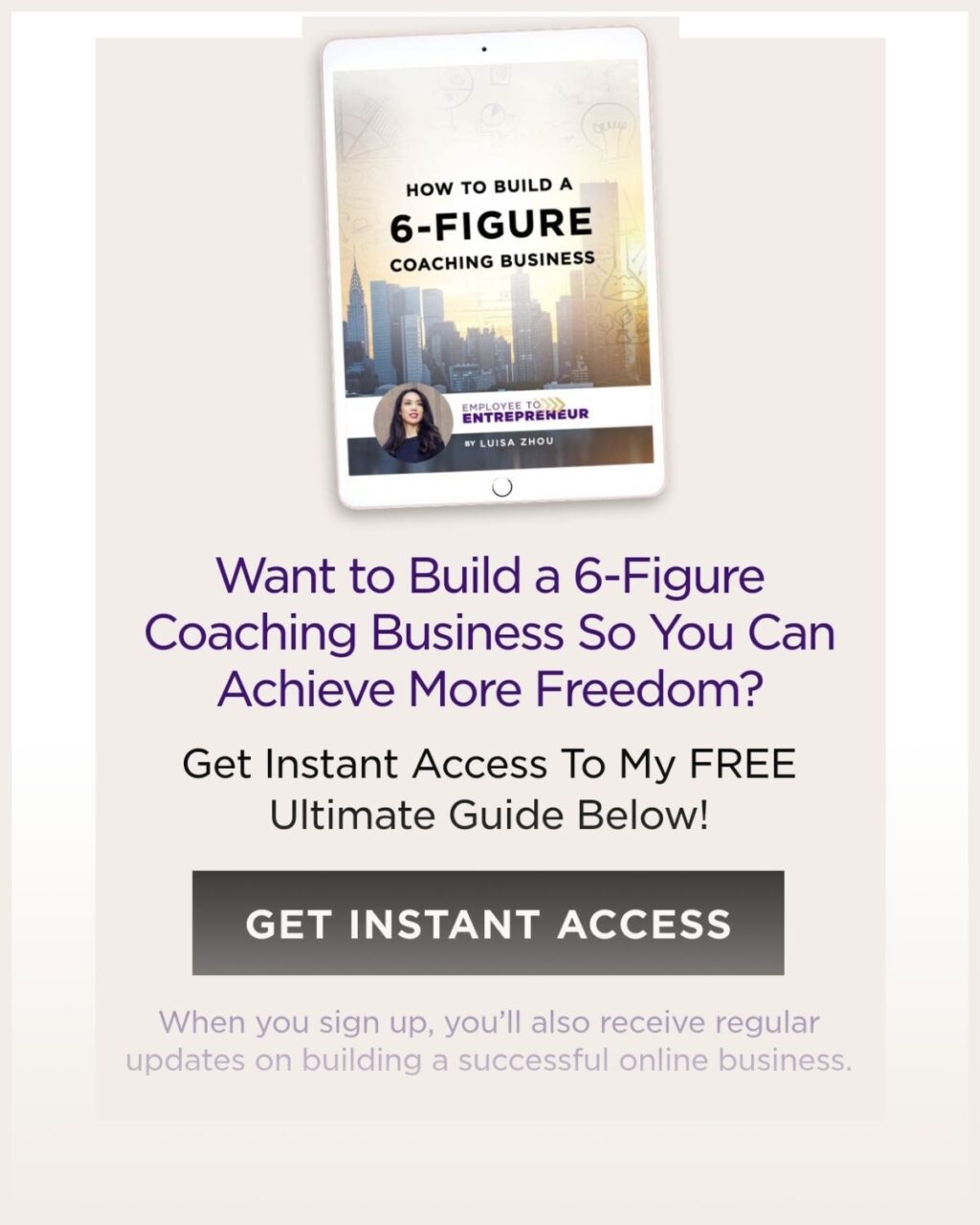
Next, you need an opt-in form so that people can download your lead magnet and join your email list.
Step 2: Set up an opt-in form
You need an email platform to host your list and create an opt-in form.
I recommend MailChimp if you don’t want to deal with too much tech. ActiveCampaign is great too but requires more setup.
Whatever email platform you choose, you need to create an opt-in form.
My advice? Keep it simple.
Just include the tagline for your lead magnet, a name box, and an email box.
After all, too many questions will turn people away.
Most email platforms have a simple embed process that will show your opt-in form on your website.
And you can use a service like OptinMonster to create pop-ups and header opt-ins.
Like I use here…

Let’s move on to step 3.
Step 3: Nurture your email list
The first email you send your new subscribers is the link to your lead magnet.
But then what?
I recommend creating a welcome sequence to introduce them to you and your services.
You want your emails to be:
- Short
- Engaging
- Valuable
For example, here’s an email I’ve shared with my subscribers that gives the reader insight into who I am as their business big sister:
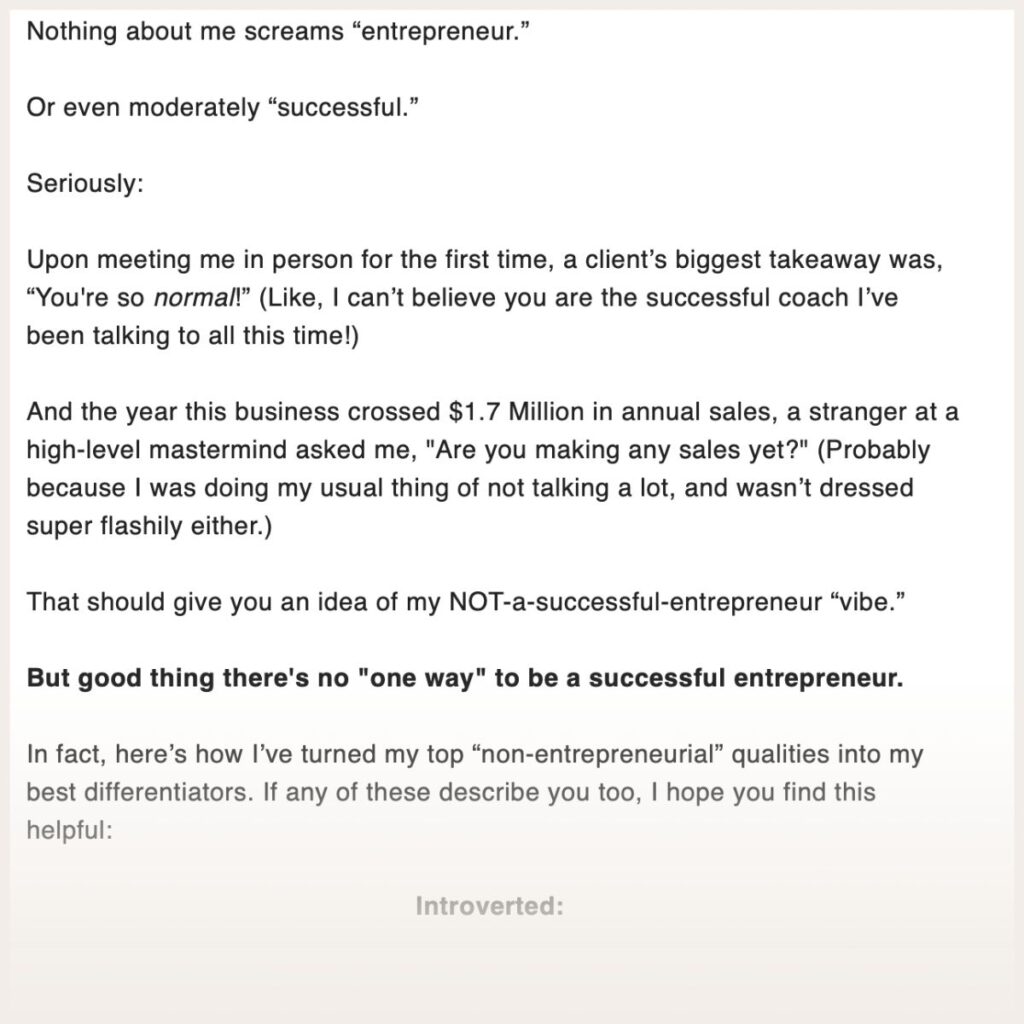
Choose how often you’re going to send emails. Aim for at least once a week to keep up their engagement.
With your email list, you have an active audience that you own. And you can start pitching your products and services to people who trust you and have signed up to hear more from you.
What’s next?
There you have it – now you know how to start a business blog.
The 4-Step Automatic Attraction System
for attracting more clients daily... without paid ads, social media, or "hustle"!
Blogging is a very clear and straightforward path to growth.
And in my hard-earned opinion after a decade of testing different strategies, online lead generation is one of the areas where you can keep it simple and use what’s been proven to work.
So if you’d like to simplify your lead generation while also growing faster, here’s what I’ve got for you…
A 4-step system that teaches you exactly how to get clients every day – automatically.
Read more
The Best Blogging Courses to Master Blogging
